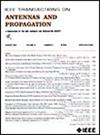基于电阻不敏感单元的低功耗1位可重构反射阵列设计
IF 5.8
1区 计算机科学
Q1 ENGINEERING, ELECTRICAL & ELECTRONIC
引用次数: 0
摘要
本文提出了一种基于电阻不敏感单元(RIUCs)的1位可重构反射阵列(RRA),用于低功耗可重构智能表面(RIS)应用。通过巧妙地将p-i-n二极管放置在h缝贴片的中间,实现了1位相位量化,这对p-i-n二极管的等效电阻不敏感。在5.09 ~ 5.62 GHz范围内,开关态相位差保持在$180^{\circ}~ $ pm ~ $ 20^{\circ}$。由于流过p-i-n二极管的电流与RIUC的总电流相比非常小,因此在p-i-n二极管处于导通状态时,RIUC具有稳定的反射损耗。利用这一特性可以减小正向偏置电流,从而实现低功耗。一个$16\ × 16$ RRA原型被制造出来。实现了峰值增益22.10 dBi的二维波束扫描性能,对应的孔径效率为24.9%。测得的1 db增益带宽为9.16%。该RRA的功耗极低,仅为1.64 mW,增益下降不到0.7 db。此外,本文还对所提出的RIUC进行了进一步的改进,使其能够在毫米波频段内良好地工作。本文章由计算机程序翻译,如有差异,请以英文原文为准。
1-bit Reconfigurable Reflectarray Design With Low Power Consumption Based on Resistance-Insensitive Unit Cells
In this article, a 1-bit reconfigurable reflectarray (RRA) based on resistance-insensitive unit cells (RIUCs) is proposed for low power consumption reconfigurable intelligent surface (RIS) applications. By tactfully placing a p-i-n diode in the middle of an H-slotted patch, 1-bit phase quantization is achieved, which is insensitive to the equivalent resistance of the p-i-n diode. The phase difference between on and off states remains $180^{\circ }~\pm ~20^{\circ }$ from 5.09 to 5.62 GHz. The RIUC has stable reflection loss in the scene of high resistance of the p-i-n diode in on state, because the current flowing through the p-i-n diode is very small, compared to the total current of the RIUC. This property is utilized to reduce the forward biasing current, thus achieving low power consumption. A $16\times 16$ RRA prototype is fabricated. The 2-D beam-scanning performance with a peak gain of 22.10 dBi is realized, corresponding to an aperture efficiency of 24.9%. The measured 1-dB gain-bandwidth is 9.16%. An extremely low power consumption of 1.64 mW for the proposed RRA is realized at the cost of less than 0.7-dB gain drop. Moreover, the proposed RIUC is further modified to operate well in the millimeter-wave frequency band.
求助全文
通过发布文献求助,成功后即可免费获取论文全文。
去求助
来源期刊
CiteScore
10.40
自引率
28.10%
发文量
968
审稿时长
4.7 months
期刊介绍:
IEEE Transactions on Antennas and Propagation includes theoretical and experimental advances in antennas, including design and development, and in the propagation of electromagnetic waves, including scattering, diffraction, and interaction with continuous media; and applications pertaining to antennas and propagation, such as remote sensing, applied optics, and millimeter and submillimeter wave techniques

 求助内容:
求助内容: 应助结果提醒方式:
应助结果提醒方式:


